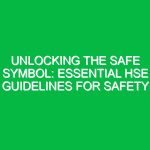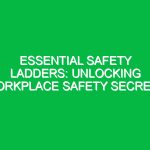# Preventing Forklift Fatalities: Essential Tips for a Safe Work Environment
Welcome, team! Today, we are going to discuss a crucial topic that directly impacts our safety at work – **Forklift Fatalities and Injuries**. This Toolbox Talk aims to equip you with essential tips and best practices to prevent accidents and promote a safe working environment.
## Understanding Forklift Fatalities and Injuries
Forklifts are indispensable tools in many industrial settings, aiding in the efficient movement of materials. However, they also pose significant risks if not operated and maintained properly. **Forklift Fatalities and Injuries** refer to accidents involving forklifts that result in severe harm or even death.
### The Importance of Safety
Ensuring safety around forklifts is not just a regulatory requirement; it is a moral obligation to protect ourselves and our colleagues from harm. By understanding the risks associated with forklift operations and implementing preventive measures, we can significantly reduce the likelihood of accidents.
## Identifying Hazards and Risks
Before operating a forklift, it is crucial to assess the work environment for potential hazards. Some common risks include:
– **Poor visibility**: Limited visibility can lead to collisions with objects or other vehicles.
– **Uneven surfaces**: Uneven terrain can cause the forklift to tip over.
– **Overloading**: Exceeding the forklift’s load capacity can impair its stability.
– **Improper training**: Inadequate training increases the risk of accidents due to improper operation.
By being aware of these hazards and taking proactive measures to mitigate them, we can create a safer work environment for everyone.
## Best Practices for Forklift Safety
To prevent **Forklift Fatalities and Injuries**, here are some essential tips to keep in mind:
1. **Proper Training**: Ensure that all operators are trained and certified to operate forklifts safely.
2. **Regular Maintenance**: Conduct routine maintenance checks to keep forklifts in optimal condition.
3. **Clear Communication**: Establish clear communication protocols to avoid accidents due to miscommunication.
4. **Safe Speed**: Adhere to speed limits and avoid reckless driving to prevent collisions.
5. **Safety Gear**: Wear appropriate personal protective equipment, such as helmets and high-visibility vests.
## Real-Life Scenario
Imagine a scenario where a forklift operator fails to secure a load properly, leading to the load falling off and causing injuries to nearby workers. This situation highlights the importance of following proper procedures and safety protocols to prevent accidents.
## Regulations and Compliance
It is essential to adhere to relevant regulations, standards, and company policies related to forklift operations. Compliance not only ensures our safety but also helps us meet legal obligations and avoid costly penalties.
## Conclusion
In conclusion, preventing **Forklift Fatalities and Injuries** is a shared responsibility that requires vigilance, adherence to safety protocols, and continuous training. By prioritizing safety in our daily operations, we can create a secure work environment for everyone.
Thank you for your attention during this Toolbox Talk. Let’s work together to prioritize safety and prevent accidents in our workplace. Stay safe, everyone!


